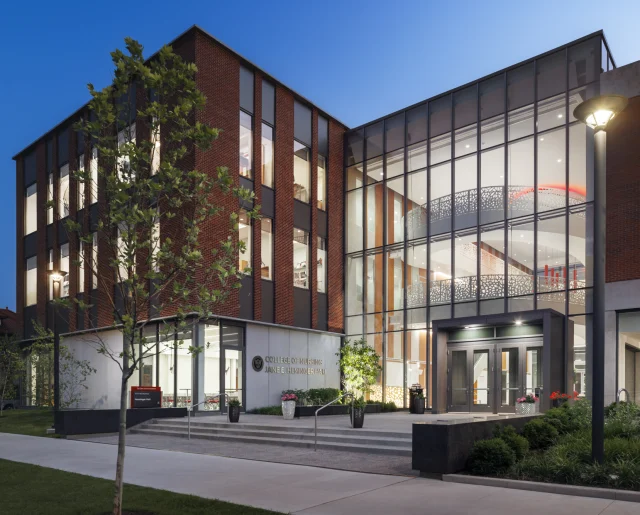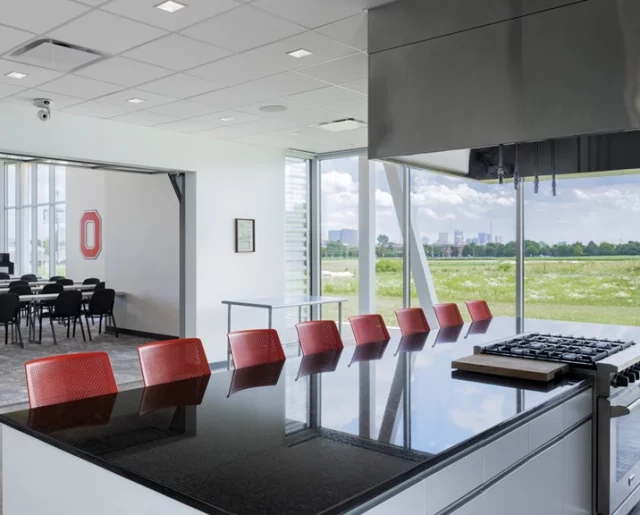Four Ways to Design Under WELL to Improve Well-Being and Mental Health Outcomes for Students and Teachers

An estimated 26% of Americans, ages 18 and older, suffer from a mental disorder in a given year. That is about one in four U.S. adults, and of that group, most do not seek treatment. Further, 40% of college students reported they felt so depressed it impaired how they functioned. This, by definition, is a health crisis.
Advocacy for healthcare starts at the education level. Moreover, the way students learn about health and well-being creates the foundation for the whole healthcare system. This said, higher education institutions and designers alike agree that a university cannot be successful without addressing the mental health of its students, faculty, and staff.
When designed under WELL standards, buildings can have a positive impact on the mental health and well-being for their occupants. The WELL Building Institute – according to their website – applies the science of how physical and social environments affect human health, well-being and performance. Developed over ten years and backed by the latest scientific research – including over 7,000 citations – WELL outlines key building-level and organizational strategies across ten categories.
The 11 WELL concepts are as follows:
- Air
- Water
- Nourishment
- Light
- Movement
- Thermal comfort
- Sound
- Materials
- Mind
- Community
- Innovation
As The Ohio State University’s College of Nursing expansion is on its final touches, we reflect on four ways to design using WELL strategies to improve well-being and mental health. These were the four primary goals for the project that were expressed during the early visioning charrettes led by MA Design with the project’s users and University stakeholders.

1 – Stress Reduction and Support for Emotional Health
The WELL Mind concept encourages health and well-being through policy, program and design strategies. These strategies and design elements are guided by research that states there is a connectedness and relationship between the mind and the body. In other words, our physical health affects our mental health and vice versa. This said, it is key that the built environment allows access to physical spaces of respite, as well the promotion of tools for the keeping of emotional health.
A space can support the physical and mental well-being of students and staff by including:
- Mental Health Promotion
- Access to Nature
- Restorative Spaces
- Respite Rooms
Overall, stress reduction and support of emotional health surrounds the idea of providing occupants an opportunity and place to replenish their energy.
2- Access to Daylight
Research shows that exposure to sunlight is critical for mental and physical health and well-being. WELL states that buildings should utilize daylight as a primary source of lighting.
The WELL Light concept requires that the following conditions are met:
- 75% of all workstations are within 25ft of an atrium or a window with views to the exterior
- 95% of all workstations are within 41ft of an atrium or a window with views to the exterior
The incorporation of daylight in the built environment improves mental health through adequate light exposure.
3- Active Movement and Exercise
The intent of the WELL Movement concept is to promote physical activity through the built environment, policies and programs.
For example, Heminger Hall incorporated a monumental staircase and designed a walking loop that is a quarter mile long. On this walking path, there are markers to display how far someone has walked, and also how many steps they’ve climbed. This walking path is also filled with inspirational quotes.

4- Social Connections and Connectedness
The WELL Community standard intends for a built environment to implement policies that foster social cohesion and community.
For example, giving students and faculty the choice and flexibility to reconfigure furniture to allow for any given situation, providing varied and activated social spaces, as well as place branded / purpose branded gathering spaces, are all design strategies to foster community and connections.
When WELL design standards are followed, it is not only about the building itself, but also the policies that are implemented under WELL certifications. Following WELL standards shows a commitment to the well-being of all who utilize a building. In the end, designing with WELL principles for students, faculty and staff reveals the deep commitment to education and fostering of mental and physical health, and supports a client’s vision of wellness.



